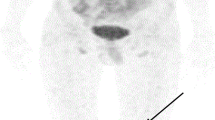Abstract
We present a case of bilateral tibial insufficiency fracture in which indium (In)-111 diethylenetriamine pentaacetic acid (DTPA) octreotide scan showed increased activity in the region of the fracture. The scan was performed in a 5-year-old girl with severe refractory hypertension and elevated plasma metanephrines for evaluation of possible neuroendocrine tumor. Octreotide scan is usually positive in neuroendocrine and some other tumors but also shows positive results in a number of other conditions. However insufficiency fracture has not been reported as a positive finding on octreotide scan in children. This may relate to the expression of somatostatin membrane receptor in activated white blood cells or expression of somatostatin receptors by bone cells.



Similar content being viewed by others
References
Balon HR, Goldsmith SJ, Siegel BA et al (2001) Procedure guideline for somatostatin receptor scintigraphy with (111) In-pentetreotide. J Nucl Med 42:1134–1138
Elliott DE, Li J, Blum AM et al (1999) SSTR2A is the dominant somatostatin receptor subtype expressed by inflammatory cells, is widely expressed and directly regulates T cell IFN-gamma release. Eur J Immunol 29:2454–2463
Papadimitriou NG, Christophorides J, Papadimitriou A et al (2007) Stress fractures in children: a review of 37 cases. Eur J Orthop Surg Traumatol 17:131–137
Van Hagen PM, Ligtenauer-Kaligig EG, Lambert SW et al (1997) Somatostatin receptor expression in clinical immunology. Immunol Letter 56:286
Romani WA, Gieck JH, Perrin DH et al (2002) Mechanisms and management of stress fractures in physically active persons. J Athl Train 37:306–314
Mackie EJ, Trechsel U, Bruns C (1990) Somatostatin receptors are restricted to a subpopulation of osteoblast-like cells during endochondral bone formation. Development 110:1233–1239
Inanir S, Unlu M, Okudan B et al (1996) Indium-111 octreotide scintigraphy in patients with bone tumours of the extremities. Eur J Nucl Med 23:987–990
Chen CC, Czerwiec FS, Feuillan PP (1998) Visualization of fibrous dysplasia during somatostatin receptor scintigraphy. J Nucl Med 39:238–240
Conflicts of interest
None
Author information
Authors and Affiliations
Corresponding author
Rights and permissions
About this article
Cite this article
Vali, R., Ranson, M., Harvey, E. et al. False-positive In-111 DTPA octreotide scintigraphy in bilateral tibial insufficiency fracture. Pediatr Radiol 45, 129–132 (2015). https://doi.org/10.1007/s00247-014-3029-6
Received:
Revised:
Accepted:
Published:
Issue Date:
DOI: https://doi.org/10.1007/s00247-014-3029-6




